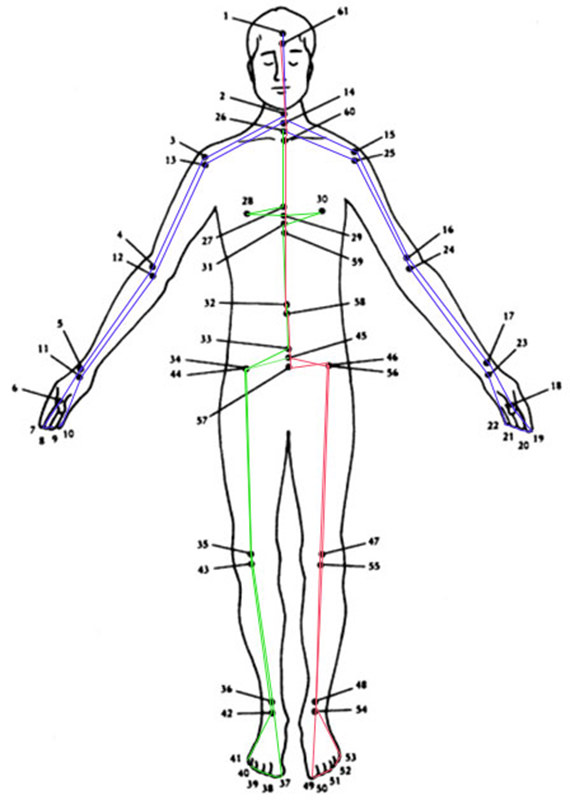The 61-Point Relaxation Technique
I first discovered The 61-Point Relaxation Technique in Exploring The World of Lucid Dreaming by Stephen LaBerge, who in turn adapted it from Exercise Without Movement by Swami Rama. With its Eastern roots, it is much more than a relaxation technique; it assumes you are accomplished in meditative breathing and can control your mental chatter so it doesn't interrupt the systematic relaxation.
The 61-point technique is easy to learn because the points fall into a fairly predictable order. Besides rejuvenation, it primes you for any kind of wake-induced lucid dreaming technique (WILD, HIT, OBE and so on). Wake-induced techniques take longer to accomplish but it is a fascinating avenue to pursue.
The 61 Points
First up, here are the 61 points. I've played dot-to-dot so you can easily get a sense of the flow (blue, green, then red). It also helps to visualize these lines to remind you where to go next when you're performing the routine tonight.

Step 1 - Memorize The 61 Points
First you need to make a mental picture of the 61 points. There's no stopping mid-way through to check you're on the right path. Once you begin, your goal is to stay completely focused on the systematic process of relaxing your mind and body.
The relaxation points start at the forehead, travel down and up your right arm, then down and up your left arm. Then they travel down your torso, down and up your right leg, and down and up your left leg. Finally, they go up your torso to your forehead.
As you study the diagram above, identify each point on your own body, remembering it's a mirror image (eg, point 5 occurs on your right hand). If you struggle to remember them all, try drawing it on paper to help cement the locations.
Step 2 - Focus Your Attention on Each Point
To begin the 61-point relaxation technique, lie down in what's known as the corpse pose. This is flat on your back with your palms facing up and your feet at shoulder-width apart. You can do this on the bed or on the floor, with a pillow under your head. Cover yourself with a light blanket because as you relax, your body temperature will drop and you don't want to be disturbed by feeling too cold.
Next, lying completely still, focus your attention between your eyebrows and visualize point one. Center your whole awareness at this point. Imagine a sense of warmth and heaviness at this spot before moving on to the next point.
Step 3 - Move Through Each Point in Sequence
In the same way, direct your awareness at each point up to point 31 (on the torso, having fully relaxed both arms). Work slowly, allowing your mind to completely train itself to each point individually, and imagining the sense of warmth and heaviness before proceeding to the next one.
After a while, you may find that your mind starts to wander. Random thoughts and mind chatter may try to takeover proceedings, and your job is to clear them away as swiftly as possible, without engaging with any of them. If you lose your place, go back to the last numbered point - or if you really go off on a tangent, start over again. This is no time for daydreaming! This is about focused awareness and conscious relaxation.
Step 4 - Extend Your Practice to All 61 Points
Once you can move through the first 31 points in sequence, extend your practice to cover all 61 points in the technique. Your goal is to cover them all without losing focus. By the time you achieve that, you will feel deeply relaxed, both in your mind and body, and you will have lost awareness of the world beyond your body.
Indeed, you will be highly focused internally and you may even find that hypnagogia and dream scenes start to emerge, especially if you practice the technique when you wake up in the night or early morning.
Once you can perform the 61-point relaxation technique without losing focus, you're ready to use it as a launch pad into wake induced lucid dreams.
















